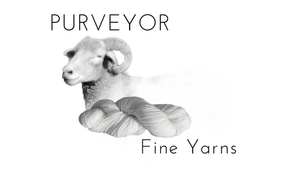The sheep after being sheared.
That beautiful skein of wool yarn, it can be hand painted in vibrant hues or it can be the natural color of the sheep, it all begins in the same place.
Shearing a large Corriedale.
Most people know that wool is produced by sheep. But not everyone understands the process of how that fleece, once separated from the sheep, becomes the wool yarn that you are knitting into a sweater (or socks or a hat or scarf).
Shearing is the process of removing the fleece from the sheep. An experienced shearer can remove the fleece in one continuous piece and do it in less than five minutes.
The first step in turning that fleece into yarn is skirting. Skirting actually takes place twice. The first time is on shearing day. When the fleece is off and the sheep has jumped up and left the stage, the fleece is picked up and tossed on the skirting table. The skirting table is a square frame covered with chicken wire or plastic mesh that is high enough to work on comfortably while standing. The mesh allows the dirt and any second cuts to fall to the floor. The frame should be large enough that an entire fleece can be opened out. In order to do the skirting quickly at shearing, one needs to see the entire fleece in one glance. One quickly removes the sections of wool that hold the most vegetable matter (VM) and grease tags. One pulls off the belly wool, the lower section of legs, the neck (if it is full of VM) and if you are skirting for handspinning, one removes the britch (this is coarse fibers on upper hind legs and around tail). One then rolls the fleece together and bags it for further skirting later. The reason that one does all of this very quickly is because a good shearer needs less than 5 minutes to shear a sheep. The skirters must have the fleece skirted and rolled up so that the skirting table is ready for the next fleece as soon as it hits the floor.
Skirting table with fleece being skirted while the shearer begins shearing the next sheep.
Not everyone does a quick skirting on shearing day. Some people just bag each fleece on shearing day and skirt later. The process is the same. One can take time and look closely at the whole fleece. The neck area should be easy to spot. If sheep are fed from above their heads, the neck will be full of VM. If sheep are fed from below the head, there will still be VM around the neck but less. When I skirt, I make a note of where the neck fleece is, but I first pull off the sections of fleece that are free of VM. As I skirt, I am separating the locks, pulling out any burrs, stickers or seed heads. Often I will skirt 60% of the fleece in 20 minutes but spend up to two hours skirting the remaining 40% of the fleece. Why? Because the remaining fleece is where the VM sits. One pulls out grease tags, the occasional blob of dried poop, and lots of seed heads, burrs and stickers. By the time I have finished skirting a fleece, I can tell you quite a bit about that sheeps pasture.
As one skirts, the skirted fleece is tossed in a bag by the handful and the bits of fleece stuck to burrs or grease tags are all dropped on the ground below the skirting table. These bits will later be swept up and added to the garden as mulch or thrown into the compost pile. Wool is a nitrogen fixer, and the poop and grease stuck in the wool will improve the soil.
When I am skirting I am also paying attention to how the wool feels. I will “ping” the wool to check the strength. If the locks break while I am skirting that is a bad sign. If the lock has a visible change in color, that can denote a weak point in the wool and it will break. If the staple breaks, it will not hold up to the stress of carding and spinning. That fleece goes in the compost.
I also pay attention to the staple length. I am preparing wool for commercial mills, most of the mills will only take fleece with a staple length of 3 - 6 inches. A few mills will take fleece with a length of 3.5 inches to 11 inches. The majority of sheep breeds that I skirt tend to have a staple length in the 3 - 6 inch range. However, it is not unusual for Romney to have a staple length of 7 - 8 inches.
As I come across bits that are very short, those are dropped. Second cuts are caused by the shearer not shearing close enough to the skin, so the shearer makes a second pass, the second pass is too short to use. I also skirt out any kemp (brittle, chalky white, it is an impurity in the wool). As I am skirting for commercial spinning, I do not skirt out the entire britch. The britch is coarser, but it is also stronger. As I am combining many fleeces to make yarn, this small amount of coarser fiber is just part of a large mix and benefits the whole.
Once the skirting is finished, the bag is closed and waits for the next step.



